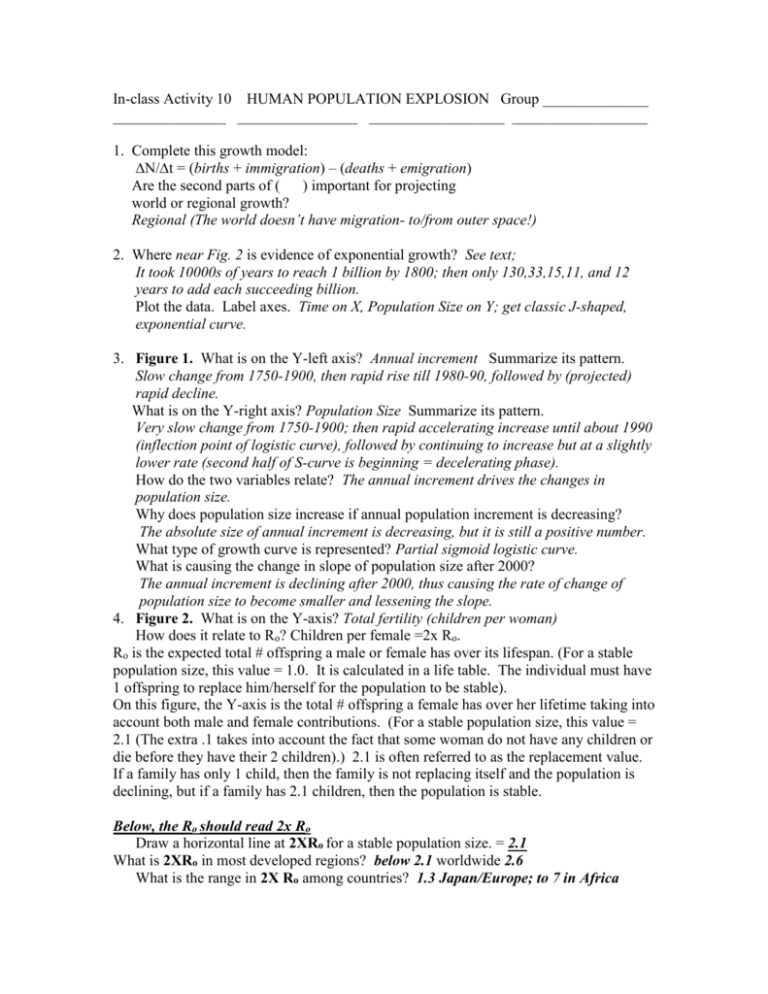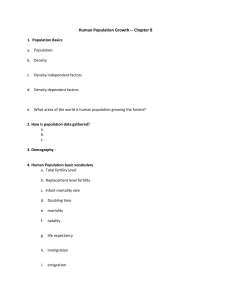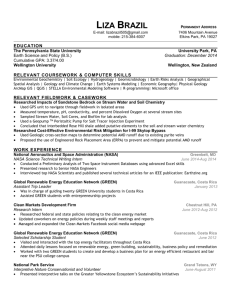10 Pop Explosion.rubric
advertisement

In-class Activity 10 HUMAN POPULATION EXPLOSION Group ______________ _______________ ________________ __________________ __________________ 1. Complete this growth model: ∆N/∆t = (births + immigration) – (deaths + emigration) Are the second parts of ( ) important for projecting world or regional growth? Regional (The world doesn’t have migration- to/from outer space!) 2. Where near Fig. 2 is evidence of exponential growth? See text; It took 10000s of years to reach 1 billion by 1800; then only 130,33,15,11, and 12 years to add each succeeding billion. Plot the data. Label axes. Time on X, Population Size on Y; get classic J-shaped, exponential curve. 3. Figure 1. What is on the Y-left axis? Annual increment Summarize its pattern. Slow change from 1750-1900, then rapid rise till 1980-90, followed by (projected) rapid decline. What is on the Y-right axis? Population Size Summarize its pattern. Very slow change from 1750-1900; then rapid accelerating increase until about 1990 (inflection point of logistic curve), followed by continuing to increase but at a slightly lower rate (second half of S-curve is beginning = decelerating phase). How do the two variables relate? The annual increment drives the changes in population size. Why does population size increase if annual population increment is decreasing? The absolute size of annual increment is decreasing, but it is still a positive number. What type of growth curve is represented? Partial sigmoid logistic curve. What is causing the change in slope of population size after 2000? The annual increment is declining after 2000, thus causing the rate of change of population size to become smaller and lessening the slope. 4. Figure 2. What is on the Y-axis? Total fertility (children per woman) How does it relate to Ro? Children per female =2x Ro. Ro is the expected total # offspring a male or female has over its lifespan. (For a stable population size, this value = 1.0. It is calculated in a life table. The individual must have 1 offspring to replace him/herself for the population to be stable). On this figure, the Y-axis is the total # offspring a female has over her lifetime taking into account both male and female contributions. (For a stable population size, this value = 2.1 (The extra .1 takes into account the fact that some woman do not have any children or die before they have their 2 children).) 2.1 is often referred to as the replacement value. If a family has only 1 child, then the family is not replacing itself and the population is declining, but if a family has 2.1 children, then the population is stable. Below, the Ro should read 2x Ro Draw a horizontal line at 2XRo for a stable population size. = 2.1 What is 2XRo in most developed regions? below 2.1 worldwide 2.6 What is the range in 2X Ro among countries? 1.3 Japan/Europe; to 7 in Africa 5. Figure 3. What is on the Y axis? Life Expectancy of Birth (yr) Summarize the trend. It increases steadily from 1950-2050, but is higher for more than less developed regions. The slope is greater for less than more developed regions. How does this trend affect population size? With ever increasing life spans, the death rate of the existing population is not declining as rapidly. Hence population size stays higher than if life expectancy were a constant value. 6. Figure 4. What two variables are on the Y-axis? Birth rate Death rate Add these values to the Y-axis: 5% at peak value; 1% low value. Complete this table. Rough estimates only. Stage 1 Stage 2 Stage 3 Stage 4 2006 (see text) Birth rate 5 5 5--1 1 2.1 Death rate 5 5--1 1 1 0.9 “r” 0 0 to 4 4 to 0 0 1.1 Stable Increasing Increasing Stable Increasing Pop at faster at slower rate rate 7. What is meant by ‘demographic transition? Declines in first death rate, then birth rate that gradually result in a lower value of r (birth-death. Which drops first, B or D? Death rate What is a consequence of this asynchrony in change of the two rates? First, as only death rate declines, a population explosion occurs because b>>>d. Then birth rate drops. When b =d, the value of r is at a much lower value than prior to the transition. Population size is much greater and longevity has increased during transition. What % of world population is in developing countries? 80% Have they completed their transition? No 8. How long did it take Sweden to complete its transition? about 150-170 years. When was its peak period of growth? about 1850 when b>>d. Is it growing today? Little, if any. Explain in terms of the value of B-D. Today, B = D, so r = 0. The growth rate is 0. Has Mexico completed its transition? No Birth rate Death rate “r” Pop 1900 48 34 14 Increasing 1925 45 25 20 Increasing Roughly complete this table. 1950 46 17 29 Increasing 1975 45 6 41 Increasing the fastest 2000 22 5 17 Increasing but less fast 9. Here are data for two developing countries. Complete the table. Haiti Costa Rica Birth rate Death rate 46 41 20 9 Doubling time 30 yr Higher or lower than Haiti? Are both countries undergoing a demographic transition? Yes Which one is at a later stage? Costa Rica Why is Costa Rica doubling time higher than Haiti? The value of r =32 for CR and 26 for Haiti. CR is higher because it has dropped its death rate to a lower value than Haiti What is the main take-home point here? Demographic transitions take time. Population explosions occur when only the death rate is altered. The more the death rate is slowed without lowering of the birth rate, the faster the population growth (= faster doubling time). 10. Figure 5. What is on the Y-axis? Average annual rate of change (%) How does this variable relate to Figure 1? It refers to the annual % change in population size (Nt+1-Nt)/Nt)100 Draw a horizontal line for a non-growing population. at 0 Worldwide population growth is 1.1% per year (=11 per thousand per year) What population parameter does this represent? r or Ro? r Complete this table. Doubling time = 70/% growth per year. What is T? Generation time How does it relate to doubling time? Generation time parallels doubling time; greater generation time greater doubling time. Most develop Worldwide Least develop % growth/yr 0.3 1.1 2.4 Double time 233 years 64 29 T 28 20 16 11. Prospects for the future (pg. 6) What is expected to happen to the death rate? Stay the same birth rate? decline Then why is the population expected to increase? The world-wide demographic transition is not complete. Birth rate still exceeds death rate so the population continues to increase until B = D. If B = D, is zero population growth (ZPG) automatically achieved? Explain. No. A population that has been growing in the past will have a high proportion of young people in their pre-reproductive + reproductive years. As it is younger people who have children there is a large time lag between the point at which the birth rate equals or falls below the death rate and the point at which the population stops rising. If 2XRo = 2.1 for the world, will population growth stop? No What other variable must be considered? Age structure of the population 12. Consider the age structures of Sweden and Costa Rica. Which population will continue to greatly increase, even if its 2XRo reaches 2.1? Costa Rica Which country is closer to having a stable age distribution? Sweden Explain why a SAD is important to stabilizing population size. Any change in B or D alters the age structure and results in a new rate of population growth. Only when there is SAD can a constant growth rate be achieved. That growth rate will be 0 only when B = D and there is SAD (see below). Can a population with a SAD still increase? Yes Answer using this figure. At SAD, each age class of the population grows at the same rate, but, as long as r (or lambda) >0, then each age class will be growing at that rate (>0).. What two factors must converge to get ZPG worldwide? 1. b = d, r = 0 2. Stable age distribution







